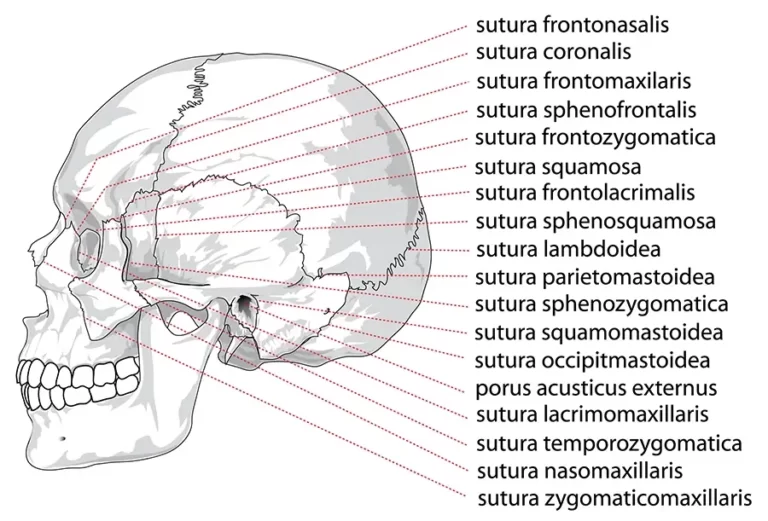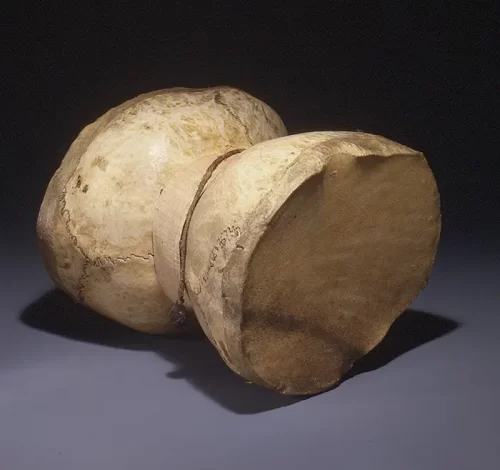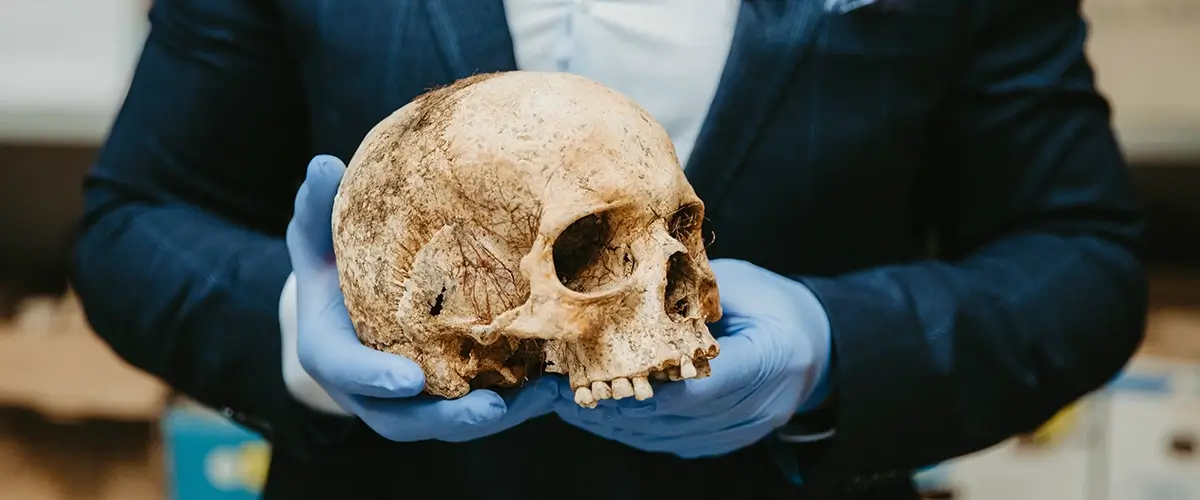The human skull protects the brain, but has also (had) other uses
The human skull. It’s a skeletal framework of the human head, composed of bones and cartilage. Its most important job is to protect the brain and some of our sense organs, and to support the face. The skull could also be called “the skeleton of the head”.
In addition to these obvious uses, the skull has (in the past, mostly?) had some other rather interesting uses as well.
Although nowadays it’s pretty rare, the human skull has actually been used for a variety of strange and sometimes macabre purposes. Some examples of human skull uses are discussed below, including using them as trophies, relics, decorations, in medicine, art, as containers, musical instruments and even currency.

By the way, how would you use a human skull, if you were so inclined, and if there were no constraints around the concept when it comes to today’s legalities, norms and attitudes? I would rather like to have a skull on my coffee table, maybe as a plant pot or as a container of… I don’t know. Pencils and such?
Or is that rude and offensive? You decide.
Let’s look at some examples below of how skulls have been used in the past!
Using human skulls as trophies
In some cultures, such as certain Native American tribes and some South Pacific islanders, human heads were taken as trophies to commemorate victory in battle.
In 2019, archeologists discovered two trophy skulls in the Belize jungle. The flesh had been removed and the skulls had been painted. They were meant to be worn around the neck as pendants. The skulls were found with a warrior buried over a thousand years ago in a Maya city of Pacbitun.
The two skulls each had holes drilled into them, likely to hold feathers and/or leather straps. Other holes anchored the jaws in place and suspended the skull around the wearer’s neck. The back of the skull was sawed off so it could lie flat on the wearer’s chest.
Using a human skull as a trophy head has been a practice in many cultures. The act of taking and preserving the head of an enemy was often seen as a way to symbolise power, dominance, and triumph over the defeated. They represented military might – they were war trophies made from the decapitated heads of defeated foes.
For example, in some Native American tribes, headhunting was seen as a rite of passage for young warriors, who sought to prove their bravery and manhood. In these cultures, heads were often displayed as trophies or hung from the rafters of homes to show the number of enemies defeated by the warrior or tribe.
Similarly, headhunting was a common practice in many tribes in the South Pacific, such as the Iban people of Borneo, the Dayak people of Kalimantan, and the Asmat people of New Guinea.
These cultures believed that capturing the heads of enemies was necessary for the spiritual well-being of the tribe, and that the spirits of the dead would continue to protect the tribe from harm.
Human skulls have been used as relics
In some religious traditions, human skulls or bones were preserved as relics and considered to have spiritual or supernatural power.
Using human skulls as relics is a practice that has been associated with some religious traditions. A relic is defined as an object or physical artifact that is venerated for its historical or spiritual significance. In some cultures, human bones or skulls have been considered relics and have been preserved, honored, and revered for their supposed spiritual power.
In Christian tradition, the bones of saints were often considered relics and were believed to have miraculous powers. Churches would often house these relics and people would make pilgrimages to these sites to seek blessings or healing.
The skull of John the Baptist is a famous example of a Christian relic. For a while there, it was unclear what had happened to the head for centuries, but it’s actually been found and is on display at the Church of San Silvestro in Gapite in Rome.
In Hinduism, the practice of preserving the skulls of holy men or sages is known as “Kapalika”. These skulls were often used in religious ceremonies and were believed to have the power to grant blessings or protection.
In some indigenous cultures, such as those in the South Pacific and Africa, the skulls of ancestors were considered to be powerful symbols of the tribe’s heritage and were revered for their spiritual significance. These skulls were often kept in special locations and were believed to provide guidance and protection to the living.
Human skulls were used as decorations
Using human skulls as decoration is a practice that has been associated with some cultures throughout history.
In these cultures, human skulls or bones were sometimes used to decorate buildings, altars, or other objects, serving as a reminder of the transience of life and the inevitability of death.
For example, in the European Middle Ages, human bones were often used to decorate ossuaries, which were underground chambers used to store the bones of the dead. These ossuaries were sometimes decorated with intricate carvings or placed in elaborate settings, and were meant to serve as a reminder of the fleeting nature of life.
In some indigenous cultures, such as the Dayak people of Borneo and the Asmat people of New Guinea, human skulls were often used as decorative elements in homes and other structures. These skulls were believed to be powerful symbols of the tribe’s heritage and were revered for their spiritual significance.
In some South American cultures, such as the Aztecs, human skulls were used as a form of decoration in religious ceremonies. The skulls were often displayed on special platforms or incorporated into elaborate headdresses, and were believed to represent the power of the gods and the sacrifice of the deceased.
Human skulls in medicine use
In the past, human skulls have been used in medical practices, such as as trepanation and phrenology. There has also been the practice of “corpse medicine” where parts of dead bodies were used as medicine ingredients.
Trepanation is a surgical procedure in which a hole is drilled into the skull, typically to relieve pressure on the brain or to treat certain medical conditions such as epilepsy. This practice has been recorded in many cultures throughout history, including ancient Greece, Rome, and South America.
Phrenology was a practice that originated in the late 18th and early 19th centuries. It was based on the idea that the shape and size of a person’s skull could be used to predict their mental abilities and character. Practitioners of phrenology would examine the bumps and indentations on a person’s head, and make predictions about their intelligence, creativity, and other traits based on the size and shape of the various regions of the skull.
Most interesting out of the practises of using human skulls in medicine is probably the practise dubbed as corpse medicine. Those who practised it, for example, extracted the moss that commonly grew on human skulls after death and used it in medicines (for example, to treat nose bleeds). This was then ingested or applied directly, along with other skull materials and often, alcohol.
Skulls have been used in art too
Using human skulls as art is a practice that has been associated with various cultures and art movements.
One example of an artwork style incorporating skulls was the vanitas, art that imitated still life and was popular in the 17th-century Europe. It served as a reminder of mortality, and the transience of life.
Human skulls and bones have been used as subject matter in paintings, sculptures, and other forms of visual art, serving as a powerful symbol of the inevitability of death.
For example, in the European Middle Ages, human bones were often incorporated into the decoration of churches and cathedrals, serving as a reminder of mortality and the fleeting nature of life. These bones were sometimes used to create intricate carvings, sculptures, and other decorative elements, and were meant to evoke a sense of awe and reverence in the viewer.
In modern art, human skulls and bones have been used as a subject matter in a variety of styles and contexts, from surrealist paintings to conceptual installations. Artists have used human skulls and bones to explore themes such as mortality, the passage of time, and the meaning of life. Some artists have also used human skulls as a means of commenting on social or political issues, such as war, violence, and the exploitation of the human body.
Using skulls as a container for either religious, spiritual or practical purposes
In some cultures, human skulls have been used as containers for liquids or other substances. This was often the case in indigenous cultures, where skulls were used to store sacred liquids or to serve as offerings to the gods.
The use of human skulls as containers has been documented in various cultures throughout history. In some cases, the skulls were used to store liquids, such as blood or other sacred substances, while in other cases they were used to store other types of materials, such as food or jewellery.
In some indigenous cultures, such as those of the Pacific Islands, or the Aztecs and the Mayans, human skulls were considered to be sacred objects and were used in religious rituals or offerings to the gods. In these cultures, the skulls were often adorned with intricate carvings or other decorative elements, and were used to store liquids that were considered to be sacred or powerful, such as blood or alcohol.
In addition to being used in religious practises, some African indigenous cultures as well as some Polynesian cultures, considered human skulls both sacred objects and symbols of power and prestige. For example, they were used in rituals to honour ancestors and to commemorate the dead.
In other cultures, human skulls were used as containers for more practical purposes, such as to store food or water. In these cases, the skulls were often treated as utilitarian objects, rather than anything sacred.
The use of human skulls as containers for practical purposes has been documented in a number of cultures throughout history. A couple of examples include:
- Indigenous cultures of the Pacific Islands: In some indigenous cultures of the Pacific Islands, human skulls were used as containers for food and other practical purposes. For example, in some Polynesian cultures, human skulls were used as bowls to store and serve food.
- European medieval society: In medieval Europe, human skulls were sometimes used as containers for alcohol or other liquids. For example, in some monasteries, human skulls were used as vessels for wine or other alcoholic beverages.
Skulls have been also used for musical instruments
In some cultures, human skulls have been used as musical instruments. For example, in Mexico, the “skull trumpet” was a wind instrument made from the jawbone of a human skull.
The use of human skulls as musical instruments has been documented in various cultures throughout history. In some cases, the skulls were used as percussion instruments, while in other cases they were used to create a unique sound by resonating the sound of a musical instrument through the skull.
As mentioned above, in some indigenous cultures, human skulls were used in religious rituals or as symbols of power and prestige, but they were sometimes incorporated into musical performances as well. For example, in some African cultures, human skulls were used as percussion instruments, and in some Polynesian cultures, human skulls were used to amplify the sound of traditional instruments such as nose flutes.
In other cultures, human skulls have been used as a means of creating a unique or eerie sound in musical performances. For example, in some European mediaeval societies, human skulls were used as resonating chambers for stringed instruments, and in some contemporary musical performances, human skulls have been used as percussion instruments or as a means of creating sounds that stand out from other instruments.
Some other examples of using skulls in musical instruments include:
- Tibetan Buddhism: In Tibetan Buddhism, human skulls have been used as musical instruments in religious rituals and offerings to the gods. For example, the thod-rnga, or damaru, is made from two human skulls. The drum is played by twisting it back and forth with one hand so that the small pellets at the ends of the strings strike the two drumheads. Severed heads are considered by Tibetan Buddhists to protect against evil.
- Hinduism: In Hinduism, human skulls have also been used as musical instruments in religious practises. The damaru has been used in Hindu ceremonies to produce a rhythm that is believed to embody the sound of the universe.
- Hindu Tantrism: In Hindu Tantrism, the damaru is also believed to be the instrument of Shiva and associated with Tantric traditions. For example, the kapalika, a type of skull-shaped drum made from a human skull, is used in Hindu Tantric ceremonies to produce a powerful and haunting sound.

Human skulls were used as weapons too
In some cultures, human skulls have been used as weapons, for example as clubs, or they were thrown as projectiles in battle.
The use of human skulls as weapons has been documented in various cultures throughout history, although it is relatively rare. Some example cultures include the Aztecs, the Polynesians and some African tribal cultures, where human skulls were sometimes used as weapons in hand-to-hand combat.
The skulls were modified to be used as clubs or bludgeons, and were often decorated with intricate designs, carvings or inscriptions.
Human skulls as currency
In some cultures throughout history, human skulls have been used as a form of currency.
This is typically seen in cultures where the acquisition of human heads or skulls has symbolic or religious significance. Also as mentioned above, skulls were used sometimes as symbols of power and prestige. Here are a few examples:
In Aztec culture, human skulls were sometimes used as a form of currency in religious or political transactions. For example, they were sometimes used to pay tribute to the gods or to purchase goods or services.
In some cultures in New Guinea and Pacific Islands, human skulls were used as a form of currency in social and economic transactions. For example, they were sometimes used as a form of payment for goods or services as well, or as a way to trade for goods or materials with other communities.
Sources and further reading
General:
- Skull – Encyclopædia Britannica
- Definition of Skull – Dictionary.com
Trophy skulls:
- Two Trophy Skulls from Pacbitun, Belize – Cambridge University Press
- Trophies made from human skulls hint at regional conflicts around the time of Maya civilization’s mysterious collapse – The Conversation
- An Osteological Study of Trophy Heads: Unveiling the Headhunting Practice in Borneo – Wiley Online Library
Skull relics:
- Where is the Head of Saint John the Baptist? – History.com
Skulls in religious practises:
- Carved human skulls found in ancient stone temple – Science.org
Skulls in musical instruments:
- Lyre – The Metropolitan Museum of Art
- The curious case of the Tibetan skull drum – Victoria and Albert Museum
Skulls in decor:
- Tracing the History of the Human Skull in Art – Academia.edu
Skulls in medicine:
- What is Trepanation – Live Science
- Phrenology – Encyclopædia Britannica
- Corpse Medicine – College of Physicians of Philadelphia

